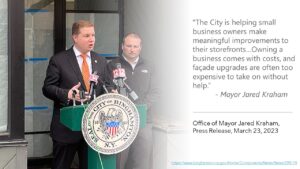At the April 12 Binghamton City Council meeting, the GOP-led Council is expected to rubberstamp, as usual, Mayor Kraham’s request to (1) launder $500,000 of COVID recovery funds through the general fund, “liberating” the federal grant dollars from program rules, and then (2) immediately allocating this same $500,000 for a commercial façade improvement grant program to help commercial property owners and small business operators.
Representatives from the Kraham administration presented the proposals to Binghamton City Council at the March 27 work session. A video recording can be found here, and the presentation starts at the 40 min 30sec mark.
According to Mayor Kraham’s own press release, the new grant program will reimburse property owners 75% of the costs to beautify the facades of their commercial properties.
The program will be run by the Binghamton Local Development Corporation (BLDC), which for years had secured state grants to offer and manage a commercial façade improvement program that helped dozens of local small business and commercial property owners. Apparently, leadership at the BLDC (and the sitting mayor exercises full control over BLDC) has abandoned its 15-year practice of competing for and winning state economic development grants and has instead chosen to raid and launder flexible, unprecedented pandemic recovery funds to beautify the walls of commercial properties.
Apparently, it’s just easier.
Mayor Kraham held a press conference of his proposals on March 23, and was joined by small business owner Jon Korchynsky who spoke in strong support of the mayor’s proposal. The press conference was held in front of the downtown building owned by Korchynsky, which by all accounts is the one neighborhood in Binghamton where values of commercial properties have skyrocketed.

Kraham’s pick for a small business owner in recovery is peculiar. In January of this year, Korchynsky purchased the old Crowley factory on Conklin Avenue for $800,000, and has announced a more than $13 million project to convert the old dairy processing plant into market-rate (luxury) apartments.
Also in January of this year, Mayor Kraham prioritized Korchynsky’s market-rate housing project in a grant application to New York State’s Restore NY Program, requesting $3,000,000 to support the developer’s market-rate housing project. Here is the resolution Kraham submitted to City Council for approval in order to request public funds on behalf of Korchynsky. It was approved unanimously.
Korchnsky’s quote at the press conference about helping small business owners hurt by the pandemic sounded nice, but he may not be the best poster child for a recovering mom-and-pop business owner in need. Moreover, a façade program may not be the most impactful way to help small businesses. This appears to be another recovery program, funded with flexible and unprecedented federal recovery dollars, designed around the “needs” of those who have unfettered access to the Mayor and his team: largely wealthy developers and downtown property owners.
There are likely thousands of households, workers, families, children, parents, homeowners, tenants, and nonprofits in Binghamton still reeling from the pandemic with needs that could be addressed with these recovery funds. Housing and mental health come first to mind.
Unfortunately—and unbelievably—nobody at the City has ever asked them.
This Wednesday when Binghamton City Council rubberstamps Kraham’s proposal, the Republicans in charge over the last two+ years will have allocated approximately 92% of the $46 million in recovery funds without holding a single community forum to hear from those most impacted by the pandemic.
The deadline to fully spend the funds is December 31, 2026.
To learn more about the $46 million in recovery funding provided to the City by the federal government, visit www.binghamtonslushfund.org, a website created by housing justice and good government advocates that seeks to bring transparency and accountability to the City’s decisions, and documents every recovery dollar allocated to date. The website is chock full of information about ARPA, how other cities have used their unprecedented recovery award, the program rules, and how to get involved. (Full disclosure, I am one of those advocates and am personally covering the website hosting costs.)
